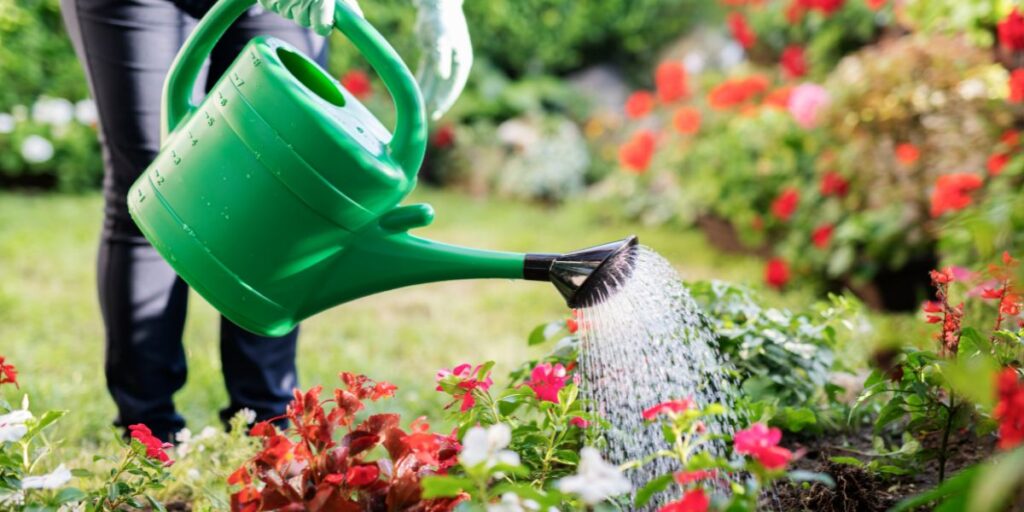Creating a vibrant and healthy landscape is a rewarding journey that begins with understanding the fundamental needs of your plants, especially their water requirements. Each plant in your garden has unique needs that are influenced by a myriad of factors including type, local climate, and soil conditions. Proper watering is critical, especially for new plants that are trying to establish themselves in your landscape. Let’s dive into the essentials of watering new landscape plants, ensuring they thrive from the start.
Understanding Plant Water Needs
The cornerstone of a thriving garden is recognizing that not all plants are created equal when it comes to water needs. Trees, shrubs, perennials, and annuals each have different requirements that must be met for them to flourish.
Trees typically have deep root systems that require less frequent but deeper watering sessions to encourage root growth.
Shrubs possess slightly shallower roots than trees, needing regular watering but with careful attention not to overwater.
Perennials are often less demanding once established, requiring watering that keeps the soil moist but not soggy.
Annuals, with their short lifecycle, usually have shallow roots that need more frequent watering to sustain their rapid growth and blooming.
Environmental factors play a significant role in watering needs. The climate of your area – be it arid, humid, temperate, or tropical – dictates the baseline water requirements. Seasonal changes further affect this, with plants generally needing more water during hot, dry spells and less during cooler, wet periods.
Soil types also dramatically impact water retention and drainage. Sandy soils drain quickly and may require more frequent watering, while clay soils hold moisture longer and are prone to waterlogging. Testing your soil and understanding its characteristics can guide you in establishing a watering routine that avoids the extremes of drought stress and waterlogging.
How Often to Water New Landscaping?

Watering new landscape plants correctly is crucial for their establishment and long-term health. Initially, these plants have limited root systems, making them highly dependent on the surrounding soil moisture. Over or under-watering can lead to poor root development or plant stress, hindering growth.
| Landscaping Element | Watering Frequency | Watering Tips |
| Seeds (Grass and Flowers) | Twice daily until germination, then reduce to once daily. | Use a fine mist to avoid washing away seeds. Keep the top inch of soil consistently moist. |
| Sod | Daily for the first 1-2 weeks, then gradually reduce as roots establish. | Ensure that water penetrates the sod and 2 inches into the soil beneath. |
| New Shrubs | 2-3 times per week for the first 2 weeks, then adjust based on weather and soil. | Water deeply to encourage root growth. Check the soil moisture to avoid overwatering. |
| New Trees | Once a week deeply, for the first few months, adjusting based on rainfall. | Water should reach deep into the soil to moisten the entire root zone. |
| Perennials and Annuals | Daily or every other day for the first couple of weeks, then as needed based on type. | Some plants prefer drier conditions, so adjust accordingly. Mulch can help retain soil moisture. |
For the first week after planting, water daily to keep the soil consistently moist but not waterlogged. This frequent watering supports the plant as it begins to establish its root system in its new environment. From the second week to the third month, reduce watering to every other day. This schedule encourages deeper root growth, as roots tend to grow towards moisture sources.
From the fourth month onwards, gradually taper off to the watering frequency recommended for established plants of the same species. This transition helps plants adapt to a routine that mimics natural rainfall patterns, promoting resilience and health.
Always adjust watering based on soil type, weather conditions, and the specific water needs of the plant species. Sandy soils require more frequent watering than clay soils, which retain moisture longer. During hot, dry periods, increase watering frequency, and during rainy spells, reduce it to prevent over-saturation.
Using a slow-release watering method, like drip irrigation or soaker hoses, can help ensure that water penetrates deeply to the roots, rather than evaporating or running off. Monitoring soil moisture regularly by feeling it a few inches below the surface can guide your watering schedule more accurately than a strict timetable.
What Is The Appropriate Amount Of Water For Newly Planted Trees Based On Size Of Trunk
| Caliper of tree trunk | Gallons of water at each irrigation |
| 1 inch | 1-1.5 gallons |
| 2 inches | 2-3 gallons |
| 3 inches | 3-4.5 gallons |
| 4 inches | 4-6 gallons |
| 5 inches | 5-7.5 gallons |
| 6 inches | 6-9 gallons |
Signs of Improper Watering
Recognizing the symptoms of improper watering is vital to correct course before stress damages or kills the plant.
Yellowing Leaves: Excessive water deprives roots of oxygen, leading to yellow leaves. Conversely, underwatering results in a similar discoloration as nutrients cannot travel throughout the plant.
Dry, Crumbling Soil: This is a clear indicator of insufficient watering. Dry soil fails to provide the necessary moisture and nutrients, leading to stressed and undernourished plants.
Soggy or Waterlogged Soil: Soil that remains wet long after watering may indicate overwatering or poor drainage. This environment promotes root rot and fungal diseases.
Leaf Drop: Both over and under-watering can lead to premature leaf drop, as the plant tries to conserve water and nutrients by reducing its leaf surface area.
Slow Growth or Stunted Growth: Improper watering affects a plant’s ability to grow. Over-watered plants may have soft, mushy growth, while under-watered plants appear stunted and sparse.
Root Rot: A tell-tale sign of over-watering. If roots appear brown, soft, and mushy rather than white and firm, it’s likely due to too much water.
Edges and Tips of Leaves Turning Brown: This often indicates that the plant is not receiving enough water, causing the cells in these areas to die.
Recognizing these signs early can prevent long-term damage, promoting a healthier, more resilient garden.
Tips for Watering New Landscape Plants Properly

Efficient water use not only conserves this precious resource but also supports healthier plant growth.
- Watering in the early morning minimizes evaporation and allows water to penetrate deeply into the soil, reaching the root zone where it’s most needed.
- Mulching around plants helps retain soil moisture, reduce weeds, and moderate soil temperature.
- Drip irrigation systems deliver water directly to the base of the plant, reducing waste and minimizing foliage wetness that can lead to disease.
As your plants establish and mature, their watering needs will change. Gradually reduce the frequency of watering to encourage deeper root growth and drought resistance. Monitor your plants and soil to adjust watering schedules based on actual growth and environmental conditions.
Conclusion
Watering new landscape plants is more art than science, requiring a blend of
knowledge, observation, and adjustment. Understanding the unique needs of your plants, considering the environmental factors and soil conditions, and being vigilant for signs of stress are key to developing effective watering practices.
Encourage experimentation and regular monitoring, adjusting as needed to ensure your garden not only survives but thrives. With care and attention, your landscape will grow into a beautiful and resilient ecosystem that brings joy for years to come.
Cutters Landscaping in Round Rock, Texas, transforms your outdoor spaces into breathtaking landscapes. Our expert team delivers personalized designs, quality maintenance, and flawless execution, ensuring your garden thrives in Austin’s unique climate. Trust us to elevate your property’s beauty and value.
Frequently Asked Questions
Q.1 How do you know when plants need watering?
Plants need watering when the top inch of soil feels dry to the touch, leaves appear wilted or droopy, and the plant looks dull or lighter in color. Also, pots may feel lighter, and some plants may start to drop leaves or show brown, crispy leaf edges.
Q.2 How do I know if I watered my plants too much?
If you’ve watered your plants too much, you’ll notice signs like yellowing leaves, wilting despite wet soil, root rot (black, mushy roots), mold or algae on the soil surface, and a constant damp, musty smell. Overwatering can also cause leaves to fall off and soil to compact.
Q.3 What will happen if plants are not watered regularly?
If plants are not watered regularly, they will undergo stress, leading to wilted or drooping leaves, stunted growth, and dry, brittle foliage. Over time, the plant’s ability to photosynthesize decreases, causing leaf yellowing, browning, and eventual shedding. Prolonged water deficiency can ultimately result in plant death.
Q.4 Is it better to overwater or underwater plants?
Underwatering plants is generally better than overwatering. While both conditions stress plants, those underwatered can often recover more easily once watered properly. Overwatering, however, can lead to root rot and fungal infections, which are more challenging to remedy and can cause irreversible damage or kill the plant.




